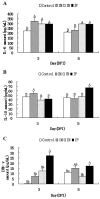Comparison of immune responses to intranasal and intrapulmonary vaccinations with the attenuated Mycoplasma hyopneumoniae 168 strain in pigs
- PMID: 25649413
- PMCID: PMC4478730
- DOI: 10.1292/jvms.14-0123
Comparison of immune responses to intranasal and intrapulmonary vaccinations with the attenuated Mycoplasma hyopneumoniae 168 strain in pigs
Abstract
The aim of this study was to evaluate the immune responses to intranasal and intrapulmonary vaccinations with the attenuated Mycoplasma hyopneumoniae (Mhp) 168 strain in the local respiratory tract in pigs. Twenty-four pigs were randomly divided into 4 groups: an intranasal immunization group, an intrapulmonary immunization group, an intramuscular immunization group and a control group. The levels of local respiratory tract cellular and humoral immune responses were investigated. The levels of interleukin (IL)-6 in the early stage of immunization (P<0.01), local specific secretory IgA (sIgA) in nasal swab samples (P<0.01); and IgA- and IgG-secreting cells in the nasal mucosa and trachea were higher after intranasal vaccination (P<0.01) than in the control group. Interestingly, intrapulmonary immunization induced much stronger immune responses than intranasal immunization. Intrapulmonary immunization also significantly increased the secretion of IL-6 and local specific sIgA and the numbers of IgA- and IgG-secreting cells. The levels of IL-10 and interferon-γ in the nasal swab samples and the numbers of CD4(+) and CD8(+) T lymphocytes in the lung and hilar lymph nodes were significantly increased by intrapulmonary immunization compared with those in the control group (P<0.01). These data suggest that intrapulmonary immunization with attenuated Mhp is effective in evoking local cellular and humoral immune responses in the respiratory tract. Intrapulmonary immunization with Mhp may be a promising route for defense against Mhp in pigs.
Figures




Similar articles
-
Co-administration of attenuated Mycoplasma hyopneumoniae 168 strain with bacterial DNA enhances the local and systemic immune response after intranasal vaccination in pigs.Vaccine. 2012 Mar 9;30(12):2153-8. doi: 10.1016/j.vaccine.2012.01.028. Epub 2012 Jan 20. Vaccine. 2012. PMID: 22266290
-
Evaluation of local and systemic immune responses induced by intramuscular injection of a Mycoplasma hyopneumoniae bacterin to pigs.Am J Vet Res. 2000 Nov;61(11):1384-9. doi: 10.2460/ajvr.2000.61.1384. Am J Vet Res. 2000. PMID: 11108184 Clinical Trial.
-
Local and systemic immune responses in pigs intramuscularly injected with an inactivated Mycoplasma hyopneumoniae vaccine.Vaccine. 2013 Feb 18;31(9):1305-11. doi: 10.1016/j.vaccine.2012.12.068. Epub 2013 Jan 7. Vaccine. 2013. PMID: 23306368
-
[Vaccines against respiratory diseases of swine: example Mycoplasma hyopneumoniae].Vet Res. 1995;26(3):213-4. Vet Res. 1995. PMID: 7795681 Review. French. No abstract available.
-
Immune responses to mycoplasma infections of the respiratory tract.Vet Immunol Immunopathol. 1985 Oct;10(1):3-32. doi: 10.1016/0165-2427(85)90037-6. Vet Immunol Immunopathol. 1985. PMID: 3909618 Review.
Cited by
-
Immunogenicity of RSV Fusion Protein Adsorbed to Non-Pathogenic Bacillus subtilis Spores: Implications for Mucosal Vaccine Delivery in Nonclinical Animal Models.Biomedicines. 2025 May 3;13(5):1112. doi: 10.3390/biomedicines13051112. Biomedicines. 2025. PMID: 40426939 Free PMC article.
-
Comparative models for human nasal infections and immunity.Dev Comp Immunol. 2019 Mar;92:212-222. doi: 10.1016/j.dci.2018.11.022. Epub 2018 Dec 1. Dev Comp Immunol. 2019. PMID: 30513304 Free PMC article. Review.
-
Development of an indirect ELISA for detecting humoral immunodominant proteins of Mycoplasma hyopneumoniae which can discriminate between inactivated bacterin-induced hyperimmune sera and convalescent sera.BMC Vet Res. 2019 Sep 12;15(1):327. doi: 10.1186/s12917-019-2077-4. BMC Vet Res. 2019. PMID: 31511007 Free PMC article.
References
-
- Barrette R. W., Szczepanek S. M., Rood D., Challa S., Avery N., Vajdy M., Kramer E., Rodriguez L., Silbart L. K.2011. Use of inactivated Escherichia coli enterotoxins to enhance respiratory mucosal adjuvanticity during vaccination in swine. Clin. Vaccine Immunol. 18: 1996–1998. doi: 10.1128/CVI.05273-11 - DOI - PMC - PubMed
-
- Dwivedi V., Manickam C., Patterson R., Dodson K., Weeman M., Renukaradhya G. J.2011. Intranasal delivery of whole cell lysate of Mycobacterium tuberculosis induces protective immune responses to a modified live porcine reproductive and respiratory syndrome virus vaccine in pigs. Vaccine 29: 4067–4076. doi: 10.1016/j.vaccine.2011.03.005 - DOI - PMC - PubMed
Publication types
MeSH terms
Substances
LinkOut - more resources
Full Text Sources
Other Literature Sources
Research Materials
Miscellaneous

